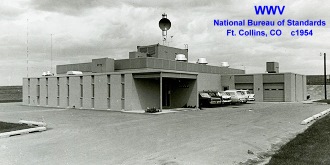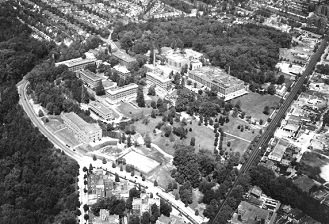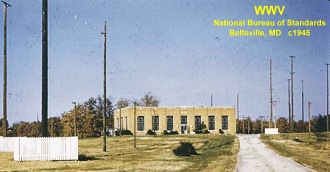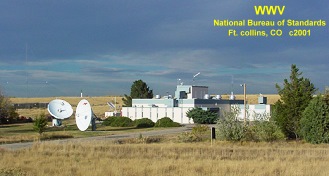|
According to the
National Bureau
of Standards' (now National Institute of Standards, NIST) website, In
October 1949, Congress authorized $4.5 million for "the construction and
equipment of a radio laboratory building for the National Bureau of Standards,"
for the planned new location of
WWV in Ft. Collins, Colorado. WWV was initially established in 1919 in
Washington, D.C., later moved to Beltsville, Maryland, then finally relocated to
Ft. Collins, Colorado, in 1955. Construction began on the facility in 1951 and was dedicated in
September 1954 by President Dwight D. Eisenhower. This item from the June 1945
issue of Radio News magazine reports on the Colorado location, with
WWV's addition of a 15 MHz time standard broadcast.
Here is an extensive paper on the history of WWV entitled "A Century of
WWV," by Glenn K. Nelson, in Journal of Research of the National
Institute of Standards and Technology. See also "WWV Moves to
Colorado," January 1967 QST.
Details and description of the entire broadcast service emanating from station
WWV.

National Bureau of Standards' WWV building c1954
Frequencies & Times
- 2.5 megacycles (= 2500 kilocycles = 2,500,000 cycles) per second, broadcast
from 7:00 P.M. to 9:00 A.M. EWT (2300 to 1300 GMT).
- 5 megacycles (= 5000 kilocycles = 5,000,000 cycles) per second, broadcast continuously
day and night.
- 10 megacycles (= 10,000 kilocycles = 10,000,000 cycles) per second, broadcast
continuously day and night.
- 15 megacycles t= 15,000 kilocycles = 15,000,000 cycles) per second, broadcast
continuously day and night.

National Bureau of Standards in Washington, D.C.

National Bureau of Standards in Beltsville (Greenbelt,
actually), MD.

National Bureau of Standards in Ft. Collins, CO.
All images from A Century of
WWV
This service comprises the broadcasting of standard frequencies and standard
time intervals from the Bureau's radio station WWV near Washington, D. C. Starting
in Feb., 1945, the service was slightly extended by broadcasting 15 megacycles at
night as well as in the daytime.
The service is continuous at all times day and night, from 10-kilowatt radio
transmitters except on 2500 kilocycles per second where 1 kilowatt is used. The
services include: (1) standard radio frequencies, (2) standard time intervals accurately
synchronized with basic time signals, (3) standard audio frequencies, and (4) standard
musical pitch, 440 cycles per second, corresponding to A above middle C.
The standard frequency broadcast service makes widely available the national
standard of frequency, which is of value in scientific and other measurements requiring
an accurate frequency. Any desired frequency may be measured in terms of the standard
frequencies. This .may be done by the aid of harmonics and beats, with one or more
auxiliary oscillators.
Four radio carrier frequencies are used; three are on the air at all times, to
insure reliable coverage of the United States and other parts of the world. The
radio frequencies are listed in the table.
Two standard audio frequencies, 440 cycles per second and 4000 cycles per second,
are broadcast on the radio carrier frequencies. Both are broadcast continuously
on 10 and 15 megacycles. Both are on the 5 megacycles in the daytime, but only the
440 is on the 5 megacycles from 7:00 P.M. to 7:00 A.M., EST. Only the 440 is on
the 2.5 megacycles.
The 440 cycles per second is the standard musical pitch, A above middle C; the
4000 cycles per second is a useful standard audio frequency for laboratory measurements.
In addition, there is on all carrier frequencies a pulse of 0.005-second duration
which occurs at intervals of precisely one second. The pulse consists of five cycles, each of 0.001-second duration, and is heard as a faint tick when listening to
the broadcast; it provides a useful standard time interval, for purposes of physical
measurements, and may be used as an accurate time signal.
On the 59th second of every minute the pulse is omitted.
The audio frequencies are interrupted precisely on the hour and each five minutes
thereafter; after an interval of precisely one minute they are resumed. This one-minute
interval is provided in order to give the station announcement and to afford an
interval for the checking of radio-frequency measurements free from the presence
of the audio frequencies. The announcement is the station call letters (WWV) in
telegraphic code (dots and dashes), except at the hour and half hour when a detailed
announcement is given by voice.
The accuracy of all the frequencies, radio and audio, as transmitted, is better
than a part in 10,000,000. Transmission effects in the medium (Doppler effect, etc.)
may result at times in slight fluctuations in the audio frequencies as received;
the average frequency received is, however, as accurate as that transmitted. The
time interval marked by the pulse every second is accurate to better than 10 microseconds
(0.000010 seconds). The 1-minute, 4-minute, and 5-minute intervals, synchronized
with the seconds pulses and marked by the beginning or ending of the periods when
the audio frequencies are off, are accurate to a part in 10,000,000.
The beginnings of the periods when the audio frequencies are off are so synchronized
with the basic time service of the U. S. Naval Observatory that they mark accurately
the hour and the successive 5-minute periods.
Of the radio frequencies on the air at a given time, the lowest provides service
to short distances, and the highest to great distances. Reliable reception is in
general possible at all times throughout the United States and the North Atlantic
Ocean, and fair reception throughout the world.
Information on how to receive and utilize the service is given in the Bureau's
Letter Circular, "Methods of using standard frequencies broadcast by radio," obtainable
on request. The Bureau welcomes reports of difficulties, methods of use, or special
applications of the service. Correspondence should be addressed National Bureau
of Standards, Washington, D. C.
Posted July 19, 2021
|













